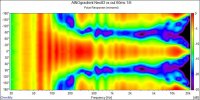- Joined
- Apr 8, 2019
- Messages
- 163
- Likes
- 212
Hey man nice setup, anything that’s better the lx521 is a nice accomplishment. Fellow owner here
Well, the proof is in the cake. Just place them in this way and listen, it's free. The 4 drivers sound at the upper baffles is perfectly integrated at that distance of 80 cm to each ear. In my experience this the minimum distance before they collapse as individual drivers.Interesting! Glad it works out
No doubt this sounds great 3d wise, Sl experimented in the very same way you did.
Only thing I'd be worried about is hearing the drivers separately due to how close they are. Also, for adding another lx521 baffles into the system, I'm 100% sure SL himself said it makes no difference to using something like minis or what you already have, so there's that, probably he would know
Out of curiosity ... I'd be interested in seeing a measurement with the Linkwitz top end swapped on to your new bass bin. Reason I'm curious is that Linkwitz spend some time optimizing his baffle shape. Duplicate his crossover points and dial them into your other unit.
I really loved your bass bins, so small and with full force cancelation. I bet they can displace a great spl without even a slight vibration. Not that the LXsub4s are bad in any way, they are also excellently designed and executed with state of the art drivers. How much is the cost of your subs relative to the LXsub4? Have you provisioned any subsonic filtering in your crossover? Subsonic content can do real damage to the Seas L26RO4Y drivers inadvertently for the user, so I usually play new music files at low volumes as SL suggested.I somehow managed to miss your former post! Sorry about that. What I'm referring to is this: http://noaudiophile.com/RMAF_2015_Day_3/
What I believe is actually happening is that lx521 is so good at what it does that it does it a bit too good. Yes, the voices sound actually really good, but something is a bit off, it's hard to express, probably because we are acustomed to hearing our own voices inside our rooms, and not really orchestras, so it bothers us a bit more when we hear voice in the phantom image very disconnected to the room itself. If that makes sense.just a theory. This would probably be remedied by your approach fully I believe.
Yes, my bins do the low end extension a bit better than lx521, and are smaller, but they do suffer from resonance appearing which is a relatively low q one and thankfully really easy to eq out. Lx subs are great, but they still do vibrate at about 50% of what they would without cancelling (which is still very nice). And yep, no need for a bridge
Also, yes, the ability to disconnect the top baffle and subs is actually true for all the speakers, not just dipoles (which probably make most use of it). Anything below Schroder would benefit from that, but it's not very practical.
Just for curiosity, when applying the HP LR4 did you notice any group delay effect? Sometimes visibly "awkward" measurements are completely unnoticed to the ear.Also, yep, I did put a high pass lr4 filter to help protect the subs.
I played them during testing to the point that I was very uncomfortable with the amount of bass in the air. My whole body was very uncomfortable. And they were perfectly fine. So I wouldn't worry about the drivers much, also, when you see them in person, they are as robust as it gets. SB really did a good job with these.






Hello from Belgium, I very impressed with your system, mostly because of the inphessis on midrange. It seem that there is agreament that the Yamaha dome midrange is one of the best, I listened, recently to the ATC dome midrange, I was very, very impressed. How do think the Yamahas compare. What cut off frequencies are you using with the D 23? What JBl drivers are you using? Are there any JBL 12 inch drivers that would fit in the Yamaha NS 1000M? Thanks, ElsI think you will be amazed at how that will sound. I was a very early fan of SL but actually if you have a four way quad amped system using reasonably selected drivers and laid out in a reasonable fashion (which SLs series of speakers were always reasonable) it is actually hard to make a system that sounds bad. It will outperfom 99% of the overpriced systems out there.
I became less of a fan of SL when I realized he had fallen under the evil influence of Nelson Pass and was charging "licensing fees" for a simple crossover network which was advertised as more complex than it probably really is. Modern DSPs make anything you want childs play. Also high prices for plans. You do all the work and he gets a licensing fee for something you are improving on.
For WAF use veneers or designer formica. That latter forms a laminate that stiffens and deadens the surfaces.
Even in te 1970s I considered building my speakers as either dipoles or omni radiators but finally decided on a line source configuration.
What drivers did you decide to use? I am always interested in very high quality drivers for relatively bargain prices. These days drivers have gotten so expensive that you can buy Yamaha Be drivers used for competitive prices. Current fleabay rules make it pretty safe to do so.
I am about to build a center channel to go with my stereo (now FL and FR ) speakers. It will look something like your design above but will only be a
three way and only need to go down as far as 80 -100 hz the rest being taken care of by multiple subs and a low frequency channel.
That's some mighty fine speakers and mightier company you've got thereSeems like we are a team!. Ardacer and JeyB! My 4-way dipole journey started in 2013, inspired by Jorma Salmi's Gradient 1.3 that I had listened at my "girl"friend's. In the beginning I needed and got a lot of help from reading sites mentioned and eg. John and Rudolf themselves. John Reekie's way of using Minidsp actually made my dream possible ( passive is almost impossible even for experts)
John Reekie https://www.hifizine.com/2011/03/refining-a-4-way-open-baffle-speaker-minidsp-2x4/
Oliver Pirlich http://www.2pi-online.de/index.html
My AINOgradient story https://www.diyaudio.com/community/threads/aino-gradient-a-collaborative-speaker-project.231353/
- I chose monopole downfire bass because of copying Gradient design and because of necessity to position the speakers rather close to the front wall!
View attachment 234710 View attachment 234709 View attachment 234711View attachment 234712
